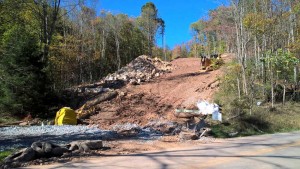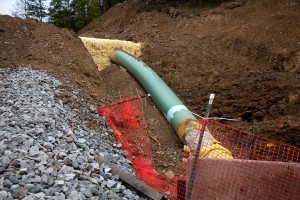Below is Push for Pipelines – Part 5. Read Part 1 here, Part 2 here, Part 3 here and Part 4 here.
Lessons to Be Learned

Construction associated with the Stonewall Gathering Pipeline, a 36-inch diameter pipeline. Photo by April Keating.
Given the many proposed large diameter and very long pipelines and the broad impact they will have, it seems useful to examine how these errors can happen. We need to ask: Are similar problems likely to happen elsewhere? Or, was this just an isolated incident? For example, can we realistically expect much better operations on the proposed Mountain Valley Pipeline, which will run more than 300 miles? The question can also be framed as: Will the much bigger pipeline projects be much better managed and executed than the smaller pipelines? Can the residents and landowners along these pipeline right-of-ways expect operations to be better on the big pipelines? Does big guarantee better?
My starting reference point is my personal experience here, not just on my property, but with the wide assortment of hundreds of miles of new pipeline constructed here in Wetzel County over the past eight years or so. What can we learn from what we’ve witnessed here? In general, the pipelines here fall into the unregulated, gathering-line category. They might be anywhere from six inches in diameter up to sixteen inches. As we review their track record, we have seen every imaginable problem, both during construction and after they were put into operation. We have had gas leaks and condensate spills, hillside mud slips, broken pipes, mud in streams, and erosion and sedimentation both during construction and afterwards.
My Assumption of Competence and Professionalism
Now for some apparently contradictory assumptions on my part. I am convinced that, for the most part, the truck drivers, pipeliners, equipment operators, drilling and fracturing crews, well tenders and service personnel at well sites all do the best job they can. If they are given the proper tools and materials, accurate directions with trained and experienced supervision, the support resources and the time to do a good job, then they will do it. Consistently and proudly. A majority of employees are dedicated, trained, competent, and hard working. Of course, there are no perfect contractors out there. These guys are human, too. On the midnight shift, we all get tired. And, of course, some pipeline contractors are better and more professional than others. And some are more experienced; some have worked on the larger pipelines. Nonetheless, significant errors and accidents and incidents will still occur.
The Inherent Contradictions Here
It seems to me that the weak link in the gas production and pipeline projects is the gas companies’ business models, as well as the weaknesses or challenges that exist in any large organization. For instance a big challenge is something i like to call the Four Cs: Command and Control and Coordination and Communication. Every organization needs to constantly focus on the Four Cs if they are to be at all successful. It is a challenge to manage these on a daily basis, even when everyone is all in the same big building, at the same time, working for the same company and speaking the same language, such as an university or large medical complex or industrial manufacturing plant.
But the Four Cs become close to impossible to manage with an organizational structure like that of the natural gas industry, which depends completely on hundreds of sub-contractors. And those companies in turn depend on a sprawling and transient, expanding and collapsing network of hundreds of other diverse and divergent independent contractors.
For example, on any given well pad during the drilling or fracturing process, there might be a few “company” men on site. Those few guys actually work for the gas company in whose name the operating permit is drawn. Everyone else is working for another company, and they are temporarily there, their loyalty is elsewhere, and they are ready to move on.
In the best of situations, with all bodies in the same building, it is next to impossible to get the right piece of information to the right person at just the right time. Coordination is also next to impossible. At times communication is literally impossible. I have seen this and listened in over my CB radio, when the drilling company is using one CB radio channel and the nearby pipeline company is using some private business band radio to talk to “his people.” In that case, the pipeline guys could not talk to the well pad. And it did not matter to them. Then again, sometimes the pilot vehicle drivers will unilaterally decide to use another CB radio channel and not tell everyone. This is a basic requirement for traffic coordination, but next to impossible to do properly and consistently.
Another example: I have watched while a massive drill rig move was significantly delayed simply because a nearby new gas processing plant was simultaneously running at least a hundred dump trucks with gravel on the same narrow roadway. The two main companies did not seem to be able communicate or coordinate their operations. They did not talk. And just on that one day, dozens of sub-contractors and trucking companies were at work.
Now, if you can, just try to picture this abysmal lack of command and control and minimal communication and coordination all along a 300-mile length of pipeline. Good luck. A FERC permit cannot fix this. Having a dozen FERC permits will not help here. The larger the pipeline diameter, and the greater the overall length of the pipeline, the more contractors will be needed. Then with more contractors and sub-contractors, the more coordination and communication is essential—but the more difficult it will be.
I do not think anyone can improve this situation. It seems to be the nature of the gas beast. If, as I know from personal experience, a major gas company can arrange to locate a surveyed control point 4,300 feet from where it should have been, then good luck with a 300-mile pipeline. No one can fix this, although improvement is possible. But, even with well-intentioned, trained employees, massive problems are still sure to come.
The FERC approvals for these pipelines might not be a done deal. But I would not bet against them. So vigilance and preparation will still be required. Citizen groups must be prepared to observe, watch, monitor and document. If these massive pipelines, like the MVP, OVC, ACP and others are ever built, they should become the most photographed, measured, scrutinized and documented pipelines since the aqueducts first delivered water to ancient Rome. Or they better be.












Do you really believe this will happen? With old lines already having right of ways, and railroads being continually subsidized by our government, let that direction be taken. Upgrade old non use pipelines that already have the right of ways established. Stop subsidizing the railroads and let them earn their money by hauling the natural gas. But oh, it is cheaper to ruin good land,air and water for profits. A bought and paid for government allows this. The land owners have NO RIGHTS AT ALL!!!!!
Bil Hughes says: “This particular pipeline, the OVC, the Ohio Valley Connector, which is the focus of my articles, was just a few weeks ago given final FERC approval. They have now started clearing trees and preparing pipe work areas and storage yards.”